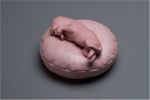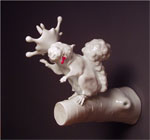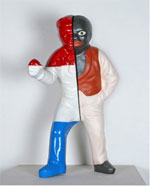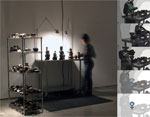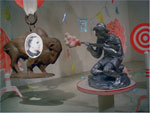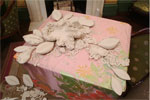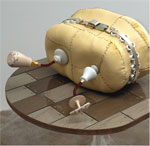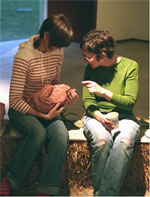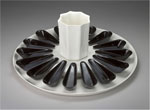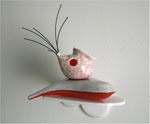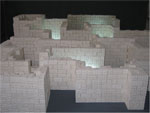
![]()
Traditions and Trends Amy Sarner Williams There is an intellectual and cultural mood within contemporary ceramics – a zeitgeist if I may – to transcend clay’s innate material qualities by embracing conceptual approaches, mixed media practices, and incorporation of new technologies and modes of presentation. This sensibility is prevalent in the work of current and recent Resident Artists at The Clay Studio in Philadelphia Pennsylvania, a dynamic east coast US city. These artists are at the forefront of a new contemporary studio craft movement. While not abandoning ceramic traditions entirely, they, and many young makers in the US and beyond, are instead demanding their rightful place within the discourse of contemporary culture. This trend is interesting given that these artists generally have MFA’s from ceramics departments and have chosen to pursue their studio practice at a ceramic art center like The Clay Studio. As Garth Clark has said, “Artists are now trained to be free agents working in any medium that captures their imagination”. Their work is a “hybridization”, according to Elizabeth Reichert, “not the hybridization of materials but the hybridization of two traditions: one of clay, and one of mainstream sculptural art and its conceptual presumptions”. The artists that I am featuring are challenging the traditional rules of material specificity and creating art with enormous potential to provoke, seduce, surprise and bewilder. Please click images for larger view
Adelaide Paul looks at animals as hot commodities, studying on the one hand, the sentimental, and on the other hand, the callous, relationship between humans and animals. As she wraps their bodies in sensuous leather, using porcelain only for small parts, or even not at all… who, she asks, is the consumer and who is the consumed?
Linda Cordell explores the historical role played by the ceramic figurine as an embodiment of mainstream, bourgeois ideology. Her sculptures of animals are not about the animals themselves, but about an ideal interpretation of nature that is sanitized and sterilized. She challenges the kitsch desire to cute-up our environment by focusing on the urge to feed, fight and breed which underlies all animal behavior.
Julie York’s work is rooted in visual perception and explores the use of objects and environments as specific forms and symbols for thought. Through a vocabulary of objects, her work references material culture with a broad range of associations, yet presents these objects through thick lenses, perceptually distorting and thus handicapping the viewer. Through using illusion, her intent is to simulate how the eye can deceive the mind.
Benjamin Schulman curated one of the most interesting exhibits at this year’s NCECA conference titled Material Transcendence: Clay as Commentary. His latest series of sculptures, comments on contemporary race relations, quite a relevant topic given the current state of US politics. Each piece addresses issues regarding race – such as exploitation, betrayal, and assimilation.
Shawn Spangler is an object maker, animator and videographer. His work is multi-sensory, incorporating animated video of his own creation, with objects and parts of objects that he intends the viewer to engage, in the creation and building of their own forms.
Ryan Kelly’s work is evolving from the static object to performance. In all pieces where paper mache is present, the forms are created as shells over solid wet clay sculptures; the ghosts of clay sculptures. He uses clay only where it makes the most impact and carries the most weight, physically and metaphorically. The subject of his work is not found in the material, but in historical narratives and musings.
Candy Depew is fascinated by the decorative arts, ornamentation, the history of design, and organization of interior space. She arranges and rearranges chosen motifs to create two-dimensional surfaces in silk-screened fabrics and three-dimensional groupings of ceramics and sculpture. For her, finding new ways to think about the things that surround us, and the spaces we inhabit, and then to cross disciplines and challenge conventional distinctions between “fine” and “applied” art, is a quest for understanding of life itself.
Colleen Toledano’s work reflects her interest in the relationship we have with our bodies and how we choose to make improvements. The most important components of her mixed-media works are the small and seemingly overlooked decorative ceramic objects, which evoke ideas of possible function or necessity.
Joanie Turbek’s interactive pieces function both as sculpture and as props for social interaction. On the left, a slip cast ceramic turkey is outfitted with a heater and a fan so that it stays warm and emits a pleasant hum. Her background in functional ceramics leads her to believe that there is a truth and honesty to objects that we approach and understand in a physical way. This lamp is designed to replicate the way sunlight is filtered through trees.
Heather Mae Erickson sees herself rediscovering function through the process of design. She welcomes design as a source and not as an adversary. Her creative approach combines industrial clarity with unique artistic execution that requires intense amounts of handling. Each piece is handled and refined so much that it looks like she never touched it. She also questions function through combining common methods of use, and proposing new formats. A prime example is using the concept of the waiters’ serving tray and morphing it together with an enlarged spoon to create a truly unique appetizer platter.
Melissa Mytty uses the cup as an object as the focus of her investigation as a designer. Her inspiration comes from historical ceramic teacups and saucers, the form as it functions, and its place in every day life. Her work draws from the rich history of ceramics, while pushing the boundaries of the material and the format of the cup.
Myung Jin Choi’s work is based on scientific theories, such as Fractals, Chaos, and Complexity, which stimulate her curiosity and motivate her creativity. The works have organic movement, varied colors, patterns and narrative stories that she hopes will stimulate the viewers' subconscious. Her works are characterized by a built-in similarity: a pattern or motif that keeps repeating. She seeks to express the coexistence of order and disorder in art, philosophy and our world. The Clay Studio is an international art center where exceptional artists converge to engage in an active discourse of contemporary culture. I invite you to join the conversation through our guest residency program. (Visit www.theclaystudio.org and click on Artist Opportunities.) I and The Clay Studio’s Artistic Director, Jeff Guido, believe that what is happening here is more than a trend: these artists are shaping the future of ceramics. Amy Sarner Williams |
